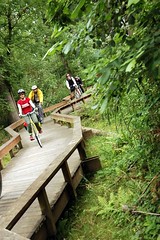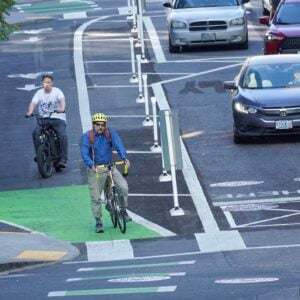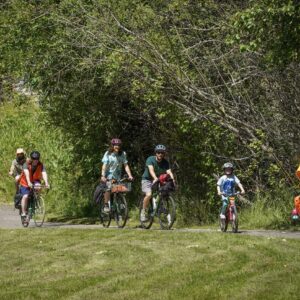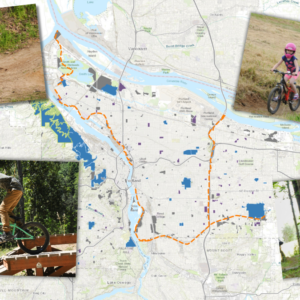A new report* estimates that our regional trail network saves us about $115 million per year in averted health care costs. The report (PDF) was done for Metro and focused on their interconnected system of trails, parks and greenways known as the Intertwine. The Intertwine (background story) consists of 1,250 miles of designated biking and walking trails, 12,000 acres of developed parks and 24,000 acres of maintained natural area and is visited by an estimated 8.3 million people each year.
In Physical Activity and the Intertwine: A Public Health Method of Reducing Obesity and Healthcare Costs, naturopathic doctor and public health expert Kurt Beil looked at the Intertwine as a public health asset. He analyzed the estimated amount of physical activity that occurs on the Intertwine and did some calculations to come up with health cost savings. Here’s an excerpt from his report:
“Subsequent estimates of obesity reduction, based on caloric expenditure, and resultant avoided healthcare costs were also conducted. These estimates are very rudimentary, but suggest that $155 million in healthcare costs may be averted annually as a result of the obesity prevention due to physical activity that occurs…”
Beil took the amount of usage the facilities receive, converted that into average calories burned, and then equated that with an estimated number of pounds lost by the physical activity on the Intertwine network.
“It is estimated that use of the Intertwine is responsible for the avoided weight gain of 17 million pounds/year among Metro region residents.”
Also as part of his analysis, Beil came up with an estimated number of annual trips made by bike across the entire Intertwine network — 81,025,291.
As advocates and agencies look to build the case for non-highway infrastructure investments, public health benefits of biking and walking are getting much more attention. Expect to see more Health Impact Assessments like this one for more transportation projects in the future.
Read the entire report via PDF here.
*Publisher’s note: The opening sentence of this story initially said a report “published.” I regret using that word because it is misleading. To my knowledge, the report has not been officially published anywhere.







Thanks for reading.
BikePortland has served this community with independent community journalism since 2005. We rely on subscriptions from readers like you to survive. Your financial support is vital in keeping this valuable resource alive and well.
Please subscribe today to strengthen and expand our work.
Kind of kicks the ‘cyclists don’t pay their fair share’ argument in the groin.
No kidding. Not only are cyclists paying more than their fair share for transportation infrastructure, but they’re paying more than their fair share for health care too.
What is a cyclist’s “fair share” of transportation infrastructure costs, specifically? Since it’s a common claim here, I’d like to know what hard information it’s based on.
Not really.
I suspect many drivers also use the trails for recreation. And there is no indication of other exercise that drivers may get to also reduce the costs of healthcare.
And school districts look to cut physical education teachers and PE programs to “save money.”
A great read. Thanks, Jonathan!
Hmm, it’s too bad it’s a study conducted by someone trained to accept conclusions without evidence because I suspect there’s some truth here. Anybody know if real studies have been done? What do they say?
Actually, the study says throughout that this is a preliminary estimate based on many assumptions, and should not be used as a definitive conclusion. Also, no, this is the first stab at a “real” study that has been conducted.
I think you’re getting a little extra heat here just because of how your preliminary doodad is being presented here on BP… as a “published report”
If I had turned this report in as a “Study” for a college course I would have been hammered for lack of relevant content, bare bones sampling, assumptions and so on… and I was a Communications major… not exactly hard hitting.
So, I’m glad you have a job and I bet you do a bunch of great work elsewhere, but if I were in your shoes I’d be a bit chagrinned to read this article, from the headline down.
It feels dishonest to claim that $115 million per year is saved in the headline, and calling your doodad a “published report” knowing full well that most folks won’t bother to read the “study,” or won’t comprehend it.
Isn’t this the sort of reporting Maus got bent out of shape for when Joseph Rose says “$600 million bike lane” and then the fine print on A10 says otherwise? Let me guess, the bar is higher at the Oregonian so JMaus is absolved.
I get the impression that when Jonathan sees a study like this, rather than reading it, he just asks himself “Does my gut tell me this is probably true?”
Aaronf,
Some of what you write is true. I regret using the word “published” in that opening line and have already edited it out and made a note saying why.
And no, I don’t think the way I presented this story is at all as irresponsible or inaccurate as someone misleadingly equating the “$600M bike plan” with the CRC or the like.
As for my gut. You’re right. I use it often and it plays an important role in all of my editorial decisions… which by the way are mine and mine alone because I am the reporter, editor and publisher. One other thing… I am not a robot. I am a flawed human being just like you who is trying to do good work and is open to criticism and I’m never above acknowledging and correcting my mistakes when they are brought to my attention. I am also transparent about my decisions.
Thanks
Jonathan, some of what you write is true. I regret comparing you to Joseph Rose. It’s true you are never above acknowledging and correcting your mistakes when they are brought to your attention. And you are also transparent about your decisions. Comparing you to the Rose was a low blow. (Pretty sure he’s a robot, too)
I should have been more clear about my specific objection, which was that the $115 million number was a number Kurt pulled out of his butt. He admits it even. So, as someone who respects the power of a headline, I’d hope you wouldn’t lead with a fantasy number.
All that the report does is raise a point: that exercising lowers health care costs… but that we have no idea how much. I’m not sure if that’s news… but it makes sense that METRO would want to do a little PR for their project.
Anyway… don’t change, Jonathan. Your site is great, your enthusiasm is great, and you clearly put a ton of work into the community.
Love,
Aaron
Kurt,
I understand that this is simply an assessment on how many calories are utilized and how that equates into pounds. I suspect that many people will use this as a bikes v. cars argument…for better or worse.
Are you doing any kind of analysis on how many average miles are put in on the network by car commuters, mass transit riders and bike commuters?
You could get a “weighted (ha ha) average” of the benefit to each user by chosen commute mode.
Also, is there any work being done to show the marginal difference of using the network? E.g., are people getting other exercise or using other facilities instead of the network? I mean, I might swim on a bad weather day instead of ride on a trail. My net calorie burn might be the same, though.
I mean, it’s just a number. There needs to be an analysis of other activities available to provide a context as to how large a role the infrastructure plays in the ‘big picture”.
Since cyclists are saving the healthcare system money, wouldn’t it be great to see the insurance industry and healthcare providers start to invest in infrastructure improvements to the cycling network in a public-private partnership?
It would be a smart business decision. Better infrastructure = more cyclists = more savings. And it would help address the funding issue surrounding the Bike Master Plan.
I thought about that as well! Wouldn’t it be awesome if health care providers provided grants to government agencies for active transportation projects? It could be used as seed money to start planning processes before expensive construction started.
Hmmm. People partake in other exercises as well. I may drive to work, but swim afterwards. Should the insurance companies subsidize pools?
But taking your observation one step further, you are actually building a conservative’s case for investment in healthcare. Lower costs to the companies, and higher productivity from workers.
What is lacking is the incentive for both company and individual to change behaviors.
Naturopath? I just wish the study had been done by a, you know, actual doctor.
He’s got a masters in public health which is more important in this type of publication than whether he has a ND or MD. MD training is no guarantee of a sound grasp of public health or even preventative medicine, sad to say.
Disclaimer: I’m an MD
If you have a PhD, you’re a doctor, regardless of your field. And this provides credibility when authoring a study. Does anyone here honestly doubt the finding due to this man’s chosen practice?
Unfortunately, yes. This project was hired out by a government agency that has a self-interest in demonstrating that their efforts are worth sustaining. It’s not science. If the study had been designed by a disinterested third party, and the methodology employed were published and peer-reviewed, then it would have much better credibility.
If I have a PhD in economics, would you trust an article I wrote about feminism anymore than someone else?
If you’re going to call this “science”, then I’ve got a global climate change denier that would like to publish a paper. The “report” is bad science. In fact, it’s not science at all: it’s conjecture based on several assumptions that don’t have any basis in reality.
As I’ve posted before, Amsterdam, that city that Portland loves, has an incredibly high bicycling rate in the city. It also has similar rates of heart disease, age of death, and cardiovascular problems as the US–even Portland. It’s well known that there so many factors affecting obesity–diet, genetics, and culture are far more useful indicators than bicycle riding–that trying to claim that one simplistic activity is responsible for something is, in a word, irresponsible.
But of course, in the words of Alice B. Toklas: “Justification for one’s beliefs is just a delusion away”.
And New York City, with incredibly high active transportation rates (walking, specifically) has worse rates of obesity and heart disease (and a slightly lower age of death) than Portland.
If the naturopath’s “study” is to be valid, then it has to apply here. If it’s applied here, then it fails. Which it does just about everywhere, in fact.
Since implementing a system of bike paths in Portland, and (as reported on this blog) with a large increase in bicycle ridership–Portland’s obesity rates and heart disease rates have INCREASED. Isn’t that strange?
Source?
Health Impact Assessments are, indeed, “science.” HIAs are not perfect and employ modeling; you know, just like NASA used to assess the best angle to enter the earth’s atmosphere with two guys housed in a tin can! You can read more about HIAs and the various methodology employed here .
And Kellie, some HIAs have even been used to assess the impacts of school-based physical education policies. Seen here .
Nice try. Can you describe the “modeling” used, and the statistical analytic methodology used to imply correlation? That’s a rhetorical question, but one that any science based conclusion should be able to answer.
And though I’m sure you’re proud of your Googling skills, “health impact assessments” were not used by NASA to calculate trajectories, and “modeling” a trajectory is, in fact, an exact science.
And, given the overwhelming amount of data that disproves the causal link that’s being implied–why aren’t you worried about that?
Is it possible that readers here don’t know about the routine commissioning of “studies” to justify otherwise untenable policy decisions? In other words, when a policy-making body commissions and pays for studies of this type, it’s desperate for data to back up its (already made) conclusions. If that kind of backwards “vision” doesn’t scare you, I don’t know what to tell you.
Why would I be surprised about the tail wagging the dog when it comes to our government? This has been its modus operandi at least for as long as I’ve been breathing. In fact, I’d go as far to say that honesty, fairness and intelligent thought generally take a back seat to self-interest in our society.
Sorry, ability to link text didn’t work..
http://www.hiaguide.org/
http://www.hiaguide.org/hia/potential-modifications-physical-education-requirements-california
What % of these folks would exercise somewhere else if this was unavailable?
This is like saying McDonalds saves 1,000,000,000 people from starving every year.
I feel for ecohuman… it’s futile trying to teach basic stat analysis to bikeportlanders for some reason…
This is canned science. The study is funded by Metro, to study Metro funded trail segments, and evaluated by Metro staff, with data from Metro.
Now all Metro staff and consultants can pat themselves on the back. Great job.
Before this was published it should have been peer reviewed. Or, blind peer-reviewed.
…and why is ‘The Intertwine’ even used as a name for a system. Why does is have to be so crafted and commercial…and need to be explained, at least twice in the report. Uggh. It is a marketing label, developed by Metro, funded by Metro…that is total NONSENSE. Why not just call is our regional multi-use trail system…you don’t have to pay consultants, develop a website, and pay for marketing with something simple.
There is too much money for stuff in the public sector…
once again… desire to share bikeportland article, killed by the comments.
Hi Ely,
What do you mean by that? I just read all the comments and it seems to me that people are just discussing what they feel are important about it.
That being said, I disagree with the tone ecohuman and some others are using, because nowhere has it been stated that his report is supposed to be the final word on this topic. It’s simply one man’s report on an issue and the fact that it was funded by Metro was not a secret.
People ride bikes and they lose weight and so they are healthier and so they use less health care. Seems obvious to me and I don’t really see why folks would get so fired up about trying to discredit either the report or the man who wrote it. Everyone’s free to have an opinion.. as long it stays respectful of course ;-).
Thanks for the comments.
The methodology to estimate miles of travel by bike on the Intertiwine is fatally flawed!
The results are ABLOLUTELY BOGUS!
The methodology essentially assumes all bicycle travel occurs along the entire length of each segment and the users do not encounter any other count location. It does not account for the fact that in a two-hour period, the user can encounter another station nor that the entire two-hour travel period cannot occur on a short segment. It’s just plain wrong!
In addition, it assumes that the peak hour accounts for only 10 percent of the total travel by bike. There is limited evidence of this for a few high-volume segments such as the Hawthorne Bridge, but no evidence that this applies to outlying streets or to trails.
On page 5, the author states “the total daily mid-week user volume is 560,7032 bicyclists and 295,221 pedestrians.” This works out to 35 percent of the metro area population using bikes on the Intertwine daily and 18 percent of the metro area population using the Intertwine trails daily. Remember, this is on the Intertwine and does not count your commute on city streets or walking through your neighborhood.
Table 5 in the appendix shows over 405 million miles of bike travel anually and 120 million miles of pedestrain travel anually on the Intertwine! That’s 1.1 million miles per day for bicycling and 0.3 million miles of walking daily on the Intertwine.
This does not pass the laugh test.
Jonathan and I have never met, and I had no communication with him or awareness of this site until someone mentioned my report was on here. That being said I think he has done a good job of summarizing my findings and reflecting the tone in which I presented them.
The purpose of this report was to help Metro and the Intertwine Alliance partners understand the potential for measuring the health benefits of the Intertwine system. This project was intended to be a light bulb or at most a searchlight for them as they begin to incorporate HIAs and other public health concepts in their work; it was not intended to be a fine-point laser. It is a first attempt to approximate the economic value of something that up until now has not been investigated by organizations primarily concerned with urban planning and public policy.
We as a region are healthier because of our extensive system of parks and trails. However, the physical activity and experiences of nature provided by the Intertwine are usually only considered as transportation alternatives or recreational amenities, and not as public health resources that act in numerous ways to promote health and decrease rates of disease. Essentially, the existing public health value of our parks and trails has been set at zero; this report is the first to suggest that it is something greater.
It will be years before we will have the research to narrow in on a true figure and the solid evidence to verify such findings. The limitations of both methodology and data for this study are mentioned at length in the report. However, rising health care costs and increasing tension over land use issues mean that we cannot ignore the need to more accurately value the resources at our disposal. In an area that has not been investigated previously, this work needs to be done and it has to start somewhere. It will be exciting to see how this process is refined and applied over time. I look forward to seeing it happen.
Kurt,
I’ve spent a few hours now analyzing your methodology and the appendices. Your basic methodological error in the calculation of activity on the trails stems from your conversion of the count data into a density of bicyclists/mile or pedestrians per mile. It is simply wrong.
Consider you are conducting counts on a path. A string of pedestrians one mile apart coming toward you. Six will pass you during the two-hour period assuming a three mph walking speed. They are one-mile apart and will pass you at 20 minute intervals. Based on your density calculation methodology, if the trail segment is 1/2 mile, your approach would yield 6 pedestrians divided by 1/2 mile = 12 pedestrians/mile. If it were a two-mile segment, you’d calculate 6 divided by 2 = 3 pedestrians per mile. But we know they are 1 mile apart. You’ve missed the fact that they travel 6 miles during the two-hour counting interval.
Using Appendix A, Table 1, for example, the correct method is to simply multiply the length specified in column 2 by the bicyclists in column 5. Divide by 5280 and you get the approximation of the miles of travel during the two-hour period by bicyclists on the sampled portion of the Intertwine. The multiply that by the appropriate figure (I’d suggest 2.5 or 3; the city would suggest 5) to get daily bike miles of travel (BMT). Multiply that by the ratio of sampled miles to total miles of the Intertwine. Multiply by days in the year (adjusted for seasonal variation) to get total annual BMT.
I think you’ll get something in the range of 30 to 50 million BMT rather than 405 million BMT.
Not to belabor it, but if you look at your calculation of density at the bottom in Table 1, it shows 172 bicyclist per mile and 90 pedestrians per mile. That’s a bicyclist every 30 feet and a pedestrian every 60 feet. With bicyclists traveling 10 mph, one would pass by your count location every two seconds! That’s clearly not happening, except maybe for half an hour daily on the Hawthorne Bridge.
It’s the density part that screwed you up. It’s unnecessary and it’s wrong since you didn’t account for distance travelled during the two-hour count period.
It seems like some people feel that if something feels basically good to them (say, promoting exercise) then the burden of proof for championing that cause should somehow be lower than if you were going to conduct a “study” on vaccinations or bridge building.
What if we were omniscient we were able to determine that the Intertwine Network (c) actually costs money in the long run, even when factoring in health care savings? Personally, I’d still be Pro-Intertwine since I feel like open space and MUPs add to quality of life and are things I value.
I feel like that’s a much more honest way to promote the network than making up numbers.
I mean… I could say that eating grapes will give you a higher SAT score by probably about 100 points, and I could tenuously link a few variables and then cook numbers to back up my hunch. I would write 3-4 pages of limitations to my study and remind everyone that these are preliminary results… is that intellectually honest? How about if I work for the grape lobby?
Kurt sez:
“It will be years before we will have the research to narrow in on a true figure and the solid evidence to verify such findings.”
Unfortunately, your study doesn’t get us ANY closer to this evidence.
A decent start would be proposing a study that might actually bring us towards solid evidence. That would be much harder work than this “study” though.